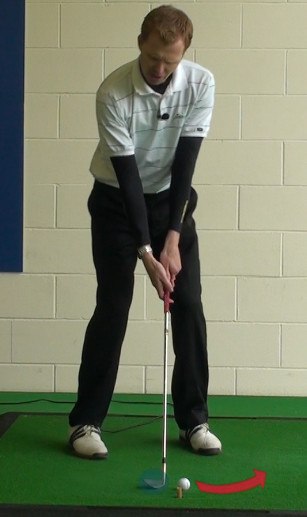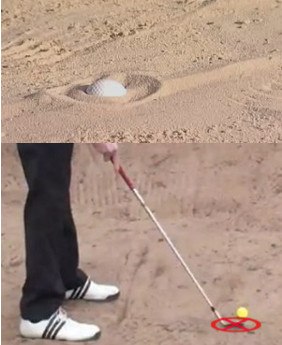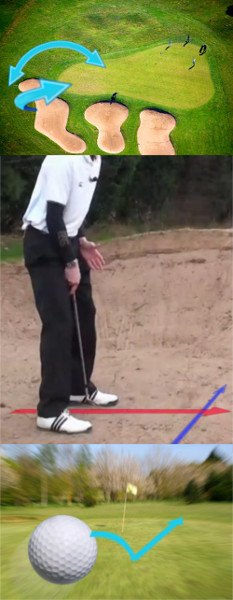
Depending on your proficiency, merely escaping a greenside bunker may be a small triumph.
But if you've got that part down pat, it's time to start aiming higher. Make that closer.
To get it close from off the green, you must know how the ball will react once it lands. This is especially true on bunker shots, which sometimes come out with left-to-right sidespin (when hit by a right-hander) and with a fair amount of loft. If the ball lands on a side slope it will bounce in the direction of the slope, and even moreso if the green tilts right.
When sizing up a bunker shot, choose the spot where you'd like to land the ball, and account for the slope's effect. It could send the ball toward the flag or way from it, so aim accordingly.
If you expect the ball to roll, study the green between the landing spot and the cup and play the break.
There is a lot to think about on any given bunker shot.

To start with, you have to evaluate the lie and how it is going to impact the shot you are able to hit. Do you have a good lie, or is the ball sitting down in the sand? Also, how far do you have to hit the ball in order to reach the target? In the world of greenside bunker shots, those that fall into the 'long' category tend to be the most difficult. Only when you have taken into consideration all of the various circumstances at play will you be able to make an appropriate plan to deal with the shot.
One important point which is often overlooked on a greenside bunker shot is the break of the green. You are used to reading the green when getting ready to hit a putt, but you may not think so much about this point when blasting the ball out of the sand. Unfortunately, ignoring the importance of the slope of the green can be a costly mistake. As you pick out a target line to use for the shot, be sure to consider what is going to happen to the ball after it lands.
Most amateur golfers tend to think of bunker shots as being extremely difficult. While they can be tough – especially if you draw a bad lie – they may not be quite as bad as you think. In fact, there are some things about playing greenside bunker shots that are rather easy. For instance, it is pretty easy to hit the ball in the intended direction when playing an explosion shot. Since the club is not actually going to hit the ball in most cases – the club will hit the sand, and the sand will propel the ball forward – you don't have to worry about precise control over the club face angle. As long as you are swinging in the right direction, the shot should be pretty accurate. With the line of the shot taken care of, you'll then just need to dial in the right distance in order to come away with a successful outcome.
All of the advice below is based on a right-handed golfer. If you happen to play left-handed, please take a moment to reverse the directions as necessary.
Preliminary Planning

Before you can really think about your line in detail, you need to sort out some other issues related to the planning on this shot. Only after the groundwork has been done can you get into the process of picking out a specific line that will serve as your target. Don't worry – this groundwork doesn't need to take long, and it isn't particularly complicated.
The three points below highlight the key things to think about when deciding how you are going to approach a greenside bunker shot.
- The lie of the ball. This is where everything starts. You need to walk down into the bunker to determine what kind of lie you have drawn. Is the ball sitting up nicely on the top of the sand, or is it sitting down, partially buried? If it is sitting cleanly, you will have plenty of options. It should be pretty easy to play a standard explosion shot, and you might even be able to play some other shots as necessary. When the ball is sitting down, however, you are going to be limited. With the ball deep down in the sand, the only real option available is to blast the ball with a big swing and hope you can get it out of the trap. This is a frustrating situation that you will hope to only run into on a rare occasion. One other point that needs to be made with regard to the lie of the ball is that you need to pay attention to the slope under your feet. Bunkers are rarely flat, especially around the edges. That means you are likely to have a sloped lie, and that is going to impact the kind of shot you can play. If the ball is resting on flat ground, or if it is slightly on the upslope, you should have plenty of options available. It is when the ball is on a dramatic upslope, or any kind of downslope, that you'll need to worry about what you can do with the ball.
- The required carry distance. Bunker shots get significantly harder as the distance that you need to carry them increases. For example, a greenside bunker shot that only needs to fly 10 yards in the air is going to be quite a bit easier than a shot which needs to travel 20 yards in the air. Take a look at the path you have available between your ball and the hole to determine how far you'll need to carry the ball. Some bunker shots give you plenty of green to use for run up, while other shots demand that you play the ball in the air almost the entire way. This factor can also influence the line you ultimately decide to use. For example, you might have to carry the ball farther if you air right at the hole than if you aim out to the left by a few feet. Taking that line to the left could be the best choice, making the bunker shot easier even if it means accepting a slightly longer putt to get up and down.
- The lip of the bunker. First and foremost, you want to get your bunker shots out of the bunker in a single swing. That might sound like an obvious point, but it one that is regularly overlooked. Golfers usually want to play the amazing shot in every situation, but that requires taking on too much risk. By playing safe and smart, you'll almost always come out better in the long run. With that in mind, you need to check on the height of the bunker lip before you settle on a plan for this shot. If you are in a deep bunker, and if the lip of that bunker is not far in front of you, it may be tough to get the ball out while still reaching the target. Instead of taking on too much risk and winding up with a shot that rolls back to your feet, give yourself plenty of margin and plan a shot that is going to clear the lip with ease.
As you can see, there is a lot to think about when playing a greenside bunker shot. At first, it may take you a few moments to stand in the bunker and think through this list. However, as you gain experience planning your shots properly, you'll soon find that this list is something you can work through in just a matter of seconds. In fact, you won't really need to think about it step-by-step at all – you'll just look at the ball and the terrain in front of you, and make a choice. It is a good idea to use a mental checklist for now, however, until you get comfortable with the decision-making process in the sand.
Identifying a Line

In the previous section, we outlined how you can get started on any greenside bunker shot by looking over the situation at hand and determining your best course of action. At this point, it is time to narrow your focus and actually pick a specific line for the shot. Obviously, the line you choose is going to be influenced to a large degree by the type of shot you have decided to hit. For instance, if you are going to attempt to fly the ball all the way to the hole, you won't need to think much about the slope of the green – your shot is going to fly over all of that slope. When playing a shot that runs along the ground, however, reading the slope is going to be essential.
The tips listed below should help you select the right line for each greenside bunker shot you face.
- Where do you want to putt from? Assuming you don't make the bunker shot, and assuming you hit the green, your next shot is going to be a putt. When planning your bunker shot, you need to think about which side of the hole would give you the best opportunity to make your putt and finish off the up and down. Usually, you will want to putt uphill, so looking toward the low side is a smart move. Remember, the goal doesn't always have to be to get the ball as close to the hole as possible, especially when steep slopes are involved. In many cases, putting uphill from five feet will be easier than putting downhill from three feet.
- Do you need to mitigate any risk? For the most part, it is going to be pretty easy to hit your intended target line when playing a greenside bunker shot. With that said, nothing is automatic in golf. You can never expect to be 100% accurate with any given shot, and that certainly applies in the bunkers. So, when picking the line you are going to use, take risk mitigation into consideration. In other words, pick a line that isn't likely to put you in further trouble. As an example, let's imagine you are playing a bunker shot to a two-tiered green, and the hole is on the high side. If you plan to run your bunker shot right along the ridge line in order to get to the hole, you will be taking on the risk that you may miss your line and wind up on the low side of the green. It may be smarter to play slightly away from the ridge, improving your chances of at least keeping the ball on the proper tier.
- Pay particular attention to the end of the shot. In terms of reading the break of the green for your bunker shot, you will want to pay specific attention to the slope around the green. As the ball slows down, it is going to take more break than it will earlier in the shot. You should read the green for the entire length of your shot, but it is the slope up near the hole that should be given the most consideration.
Realistically, you aren't going to have much trouble picking a target line for most of your bunker shots. A typical bunker shot isn't going to involve too much risk, and the slope of the green usually won't be too severe. With that said, you still need to consider the break you are going to deal with between the ball and the hole, just to make sure you have the best possible chance for success. And, when a situation does arise where you need to make a careful decision to avoid potential trouble, we hope the tips provided so far in this article will point you in the right direction.






